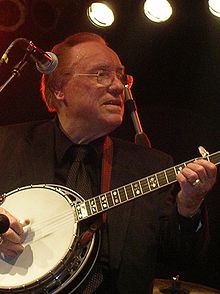Earl Scruggs dies at age 88
Earl Scruggs (who died Wednesday at age 88) was the banjo player of his time, right? Right. He defined the sound of a bluegrass band with his banjo style, right? Right. A bluegrass band without a Scruggs-style banjo isn’t a bluegrass band, right? It may be a country band, a folk band or some kind of jazz band, but it’s not a bluegrass band, is it? Right about that, too.
You’d think transforming the way people worldwide play, perceive and enjoy one instrument would be enough of a contribution for one musician. But with musicians as inspired as Scruggs, peeling back the sparkling outer layer often reveals more glowing layers within.
In Scruggs’ case, when you gently peel back the banjo layer of his musical persona, you find a guitar player as impressive as the banjo picker, as well as a gospel singer the equal of any in the finest Southern traditional quartet.
Scruggs’ finger-picked guitar (which often came front and center in the Foggy Mountain Boys’ religious numbers) was memorably powerful and fluid. Check it out here on this late-40′s Flatt & Scruggs recording of “God Loves His Children.” Bluegrass and acoustic musicians love to listen to and study his guitar work, which is easily the equal of his banjo playing in its sheer power, its creative noting and syncopation, rich tone and fluidity.
It may be impossible to overstate the importance of bluegrass legend Earl Scruggs to American music. A pioneering banjo player who helped create modern country music, his sound is instantly recognizable and as intrinsically wrapped in the tapestry of the genre as Johnny Cash’s baritone or Hank Williams’ heartbreak.
Scruggs died Wednesday morning at age 88 of natural causes. The legacy he helped build with bandleader Bill Monroe, guitarist Lester Flatt and the rest of the Blue Grass Boys was evident all around Nashville, where he died in an area hospital. His string-bending, mind-blowing way of picking helped transform a regional sound into a national passion.
“It’s not just bluegrass, it’s American music” – bluegrass fan turned country star Dierks Bentley said. “There’s 17- or 18-year-old kids turning on today’s country music and hearing that banjo and they have no idea where that came from. That sound has probably always been there for them and they don’t realize someone invented that three-finger roll style of playing. You hear it everywhere.”
Country music has transcended its regional roots, become a billion-dollar music and tourist enterprise, and evolved far beyond the classic sound Monroe and The Blue Grass Boys blasted out over the radio on The Grand Ole Opry on December 8, 1945. Though he would eventually influence American culture in wide-ranging ways, Scruggs had no way of knowing this as he nervously prepared for his first show with Monroe. The 21-year-old wasn’t sure how his new picking style would go over.
“I’d heard The Grand Ole Opry and there was tremendous excitement for me just to be on The Grand Ole Opry” – Scruggs recalled during a 2010 interview at Ryman Auditorium, where that “big bang” moment occurred. “I just didn’t know if or how well I’d be accepted because there’d never been anybody to play banjo like me here. There was Stringbean and Grandpa Jones. Most of them were comedians.”
For better or worse, Earl Scruggs will be remembered by most Americans for his banjo picking alongside partner Lester Flatt in a dated 1960′s cultural artifact – “The Beverly Hillbillies.”
For better, because the style that the bluegrass legend, who died Wednesday at 88, showcases will forever live in the memories of generations. For worse, because the song threatens to define Flatt and Scruggs, as well as the whole of the uniquely American form of bluegrass music, alongside the zany, know-nothing Clampetts of Beverly Hills. That placement has helped define bluegrass to the culture at large as music for hicks who dance at hoedowns and wouldn’t know a lick about “real” music. (Credit goes to “Deliverance” and “Dueling Banjos” for furthering the cause.)
That’s a shame, because a deep listen to Flatt & Scruggs reveals something so much bigger than a few unfortunate stereotypes. The sound that Scruggs forged, a three-fingered picking style in the 1940′s as a central player in Bill Monroe’s Blue Grass Boys, came to define bluegrass. When he and Flatt struck out on their own in 1948 to form the Foggy Mountain Boys, the style had woven its way into the fabric of American music.
It’s a sound that still thrives today in the work of Alison Krauss and Union Station, Ricky Skaggs, Bela Fleck, and Abigail Washburn, among many others. Virtually every time a banjo solo comes on the radio, it’s played in a Scruggs-inspired picking style, and every time a TV character steps onto a farm, you can hear the spirit of Earl Scruggs. You can even get a taste of it on Madonna’s new album, where her song “Love Spent” opens with a Scruggs-suggestive lick.
But that influence has spread because Scruggs never defined himself as simply a bluegrass player. As his success on the country circuit rose in the 1960s and a generation of hippies discovered the glory of the old-time country music of Bill Monroe, the Foggy Mountain Boys, the Stanley Brothers and Dock Boggs, Scruggs expanded his reach.
